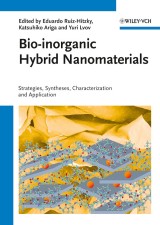Details

Bio-inorganic Hybrid Nanomaterials
Strategies, Synthesis, Characterization and Applications1. Aufl.
|
205,99 € |
|
| Verlag: | Wiley-VCH |
| Format: | |
| Veröffentl.: | 25.06.2008 |
| ISBN/EAN: | 9783527621453 |
| Sprache: | englisch |
| Anzahl Seiten: | 521 |
DRM-geschütztes eBook, Sie benötigen z.B. Adobe Digital Editions und eine Adobe ID zum Lesen.
Beschreibungen
This ready reference is the first to collate the interdisciplinary knowledge from materials science, bioengineering and nanotechnology to give an in-depth overview of the topic. As such, it provides broad coverage of combinations between inorganic materials and such key biological structures as proteins, enzymes, DNA, or biopolymers. With its treatment of various application directions, including bioelectronic interfacing, tissue repair, porous membranes, sensors, nanocontainers, and DNA engineering, this is essential reading for materials engineers, medical researchers, catalytic chemists, biologists, and those working in the biotechnological and semiconductor industries.
Bio-mineralization: Bio-mineral Inspired Materials<br> Biopolymer-Silica Nanocomposites<br> Bio-nanohybrids Based on Silica and Biological Molecules<br> Porous Membranes for Applications in Bionanotechnology<br> Hydroxyapatite-based Bionanocomposites<br> DNA-based Nanohybrids<br> Bio-inorganic Hybrids Based on Enzymes<br> Hybrid Nanocomposites at the Biology/Electronics Interphase<br> Development of Bioactive Organic-inorganic Hybrids with High Flexibility<br> Development and Medical Application of Cartilage-, Nerve- and Ligament-regeneration Materials by Controlled Organic-inorganic Interaction<br> Polymer-inorganic Nanohybrids as Bio-inspired Materials<br> Biomaterial Arrays on Inorganic Surfaces for Sensor Applications<br> Fabrication of Novel Bio-inorganic Nanohybrid Materials via Supramolecular Approaches<br> Proteins in Inorganic Mesoporous Materials<br> Nano- and Meso-scale Bio-inorganic Hybrid Materials<br> Functional Capsules of Bio-inorganic Nanohybrids<br> DNA-engineering on Inorganic Nanoparticles<br> Halloysite Clay Nanotubules as a Container for Biomolecules
"This book is an excellent research reference for readers in various disciplines … .Essential reading for materials scientists, chemists, chemical engineers, bioengineers nanotechnologists and medical researchers." (<i>ChemBioChem</i>, September 2008) <p>"It demonstrates the pace and advancement of research in these areas while showing several examples that are interest to wider audiences." (<i>Journal of the American Chemical Society</i>, July 9, 2008)</p>
Eduardo Ruiz-Hitzky is the director of the Department of Porous Materials and Intercalation Compounds at the Materials Science Institute of Madrid (CSIC), Spain. His research work during the last 30 years has focused on organic-inorganic hybrids and bio-nanocomposite materials. Professor Ruiz-Hitzky has authored over 150 scientific publications and edited two journal special issues, one of them (now in preparation) on bio-nanohybrid materials. He has received several scientific awards from different countries, including the AIPEA Medal from the International Association for the Study of Clays (Tokyo, 2005).<br> <br> Katsuhiko Ariga is the director of the Supermolecules Group at the National Institute for Materials Science (NIMS), Japan. His research work during the last 20 years has focused on fabrication of nanostructured materials through specific interaction at interfaces, creating novel hybrids of inorganic, organic and biological materials. Dr. Katsuhiko Ariga has authored over 230 scientific publications and received more than 3600 citations. He has published three text books on supramolecular chemistry and served as an editor of one book and one journal special issue on nanomaterials.<br> <br> Yuri M. Lvov is Chemistry Professor and Pipes Endowed Chair on Micro and Nanosystems at Louisiana Tech University, USA. Earlier, he worked in the Center for Biomolecular Science and Engineering at the Naval Research Laboratory. He is author of more than 150 scientific publications on ultrathin films, biomaterials, clay nanocomposites, and nanocapsules for sustained drug release. Professor Yuri Lvov was among the pioneers of the layer-by-layer nanoassembly technique based on alternate adsorption of oppositely charged components with more than 4000 citations of these works.
This ready reference is the first to collate the interdisciplinary knowledge from materials science, bioengineering and nanotechnology to give an in-depth overview of the topic. As such, it provides broad coverage of combinations between inorganic materials and such key biological structures as proteins, enzymes, DNA, and other biopolymers. With its treatment of various application directions, including bioelectronic interfacing, tissue repair, porous membranes, sensors, nanocontainers, and DNA engineering, this is essential reading for materials engineers, medical researchers, catalytic chemists, biologists, and those working in the biotechnological and semiconductor industries.<br> <br> Eduardo Ruiz-Hitzky is the director of the Department of Porous Materials and Intercalation<br> Compounds at the Materials Science Institute of Madrid (CSIC), Spain. His research carried out during the last 30 years has been at the frontier between organic and inorganic chemistry, mainly focusing on nanostructured organic-inorganic hybrids and, more recently, on bio-hybrid composite architectures. Special emphasis has been placed on intercalation and grafting reactions involving clay minerals and related inorganic solids, pioneering the development of functional polymer and bio-polymer clay nanocomposites. Professor Ruiz-Hitzky has authored over 150 scientific publications, registered numerous patents and edited two journal special issues. He has received several international scientific awards, including the AIPEA Medal from the International Association for the Study of Clays (Tokyo, 2005).<br> <br> Katsuhiko Ariga is the director of the Supermolecules Group at the National Institute for Materials Science (NIMS), Japan. His research work during the last 20 years has focused on fabrication of nanostructured materials through specific interaction at interfaces, creating novel hybrids of inorganic, organic and biological materials. Dr. Katsuhiko Ariga has authored over 300 scientific publications and received more than 5000 citations. He has published three text books on supramolecular chemistry and served as an editor of one book and one journal special issue on nanomaterials.<br> <br> Yuri Lvov is Chemistry Professor and Pipes Endowed Chair on Micro and Nanosystems at Louisiana Tech University, USA. Earlier, he worked in the Center for Biomolecular Science and Engineering at the Naval Research Laboratory. He is author of more than 150 scientific publications on ultrathin films, biomaterials, clay nanocomposites, and nanocapsules for sustained drug release. Professor Yuri Lvov was among the pioneers of the layer-by-layer nanoassembly technique based on alternate adsorption of oppositely charged components with more than 4000 citations of these works.<br> <br> <br>
Diese Produkte könnten Sie auch interessieren:

Mass Spectrometry of Inorganic and Organometallic Compounds

von: William Henderson, J. Scott McIndoe

59,99 €

Neurodegenerative Diseases and Metal Ions, Volume 1

von: Astrid Sigel, Helmut Sigel, Roland K. O. Sigel

228,99 €














